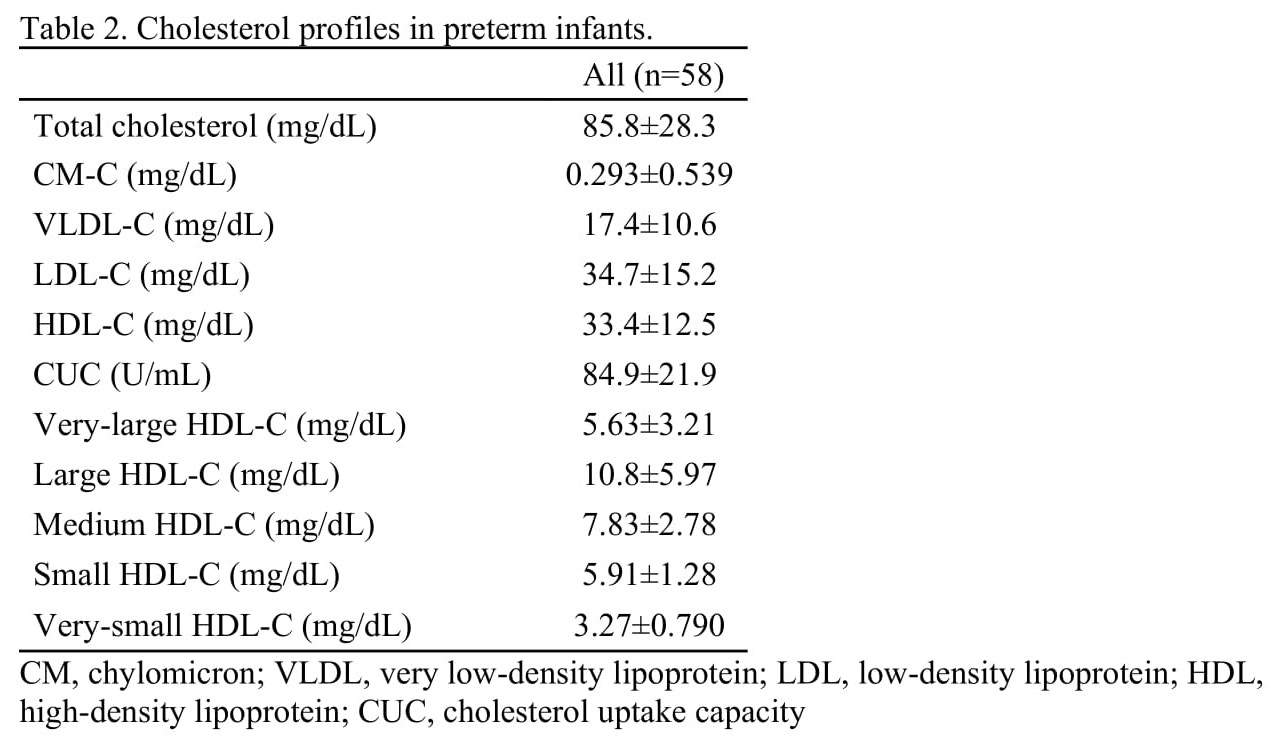Back
Neonatal Fetal Nutrition & Metabolism
Category: Abstract Submission
Neonatal Fetal Nutrition & Metabolism II
285 - Cholesterol uptake capacity in umbilical cord blood of preterm infants
Friday, April 22, 2022
6:15 PM – 8:45 PM US MT
Poster Number: 285
Publication Number: 285.120
Publication Number: 285.120
Nobuhiko Nagano, Department of Pediatrics and Child Health, Nihon University School of Medicine, Tokyo, Tokyo, Japan; Kazumasa Fuwa, Nihon University, Nerima-ku, Tokyo, Japan; Fujihiko Iwata, Wakakusa Children's Clinic, Toda, Saitama, Japan; Tomoo Okada, Kanagawa institute of technology, ATSUGI, Kanagawa, Japan; Ichiro Morioka, Nihon University School of Medicine, Itabashi, Tokyo, Japan
- KF
Kazumasa Fuwa, MD, PhD
Staff Neonatologist
Nihon University
Nerima-ku, Tokyo, Japan
Presenting Author(s)
Background: High-density lipoprotein-cholesterol (HDL-C) is composed of several subclasses that play different roles in arteriosclerosis in adults. In newborns, HDL-C, specifically large-size HDL-C, is important in normal growth. Cholesterol efflux capacity (CEC) is the standard used for assessing HDL functionality. In adults, CEC reflects the efflux of cholesterol from macrophages in the arterial wall and reverse cholesterol transport, but this measurement is complicated and time-consuming because it requires radioisotope-labeled cholesterol and cultured macrophages. Consequently, a cell-free assay system for measuring the capacity of HDL to accept cholesterol or cholesterol uptake capacity (CUC), was recently developed.
Objective: To investigate the relationship between CUC and anthropometric measurements, HDL-C levels, and HDL-C subclasses in preterm infants.
Design/Methods: Fifty-eight preterm infants were included in this study. At birth, the umbilicus was double-clamped, and cord blood was sampled from the umbilical vein. CUC was measured using a fully automated immunoassay system, HI-1000. HDL-C subclasses were measured using high-performance liquid chromatography. Bivariable normal ellipses were used to assess correlations between the variables. Standard deviation scores (SDS) for BW, BL, and birth head circumference by GA, according to sex-specific standards based on the Japanese population.
Results: Study participants demographics are shown in Table 1 and cholesterol profiles in Table 2. Mean gestational age (GA), birthweight (BW), and CUC were 31.6±3.40 wks, 1,460±594 g, and 84.9±21.9 (U/mL). A positive correlation between CUC and BW (SDS) (r=0.46, p < 0.05), height (SDS) (r=0.46, p < 0.05), and head circumference at birth (SDS) (r=0.26, p < 0.05). Moreover, CUC had a strong relationship with HDL-C (r=0.74, p < 0.05) and very large (r=0.68, p < 0.05), large (r=0.72, p < 0.05), and medium (r=0.69, p < 0.05) HDL-C.Conclusion(s): In preterm infants, CUC is associated with normal growth as observed by its positive correlation with anthropometric measurements. We speculate that this observation may indicate the ability to transport cholesterol from the mother to the fetus by large-or medium-size HDL-C.
Characteristics of the study participants.jpg)
Cholesterol profiles in preterm infants.
Objective: To investigate the relationship between CUC and anthropometric measurements, HDL-C levels, and HDL-C subclasses in preterm infants.
Design/Methods: Fifty-eight preterm infants were included in this study. At birth, the umbilicus was double-clamped, and cord blood was sampled from the umbilical vein. CUC was measured using a fully automated immunoassay system, HI-1000. HDL-C subclasses were measured using high-performance liquid chromatography. Bivariable normal ellipses were used to assess correlations between the variables. Standard deviation scores (SDS) for BW, BL, and birth head circumference by GA, according to sex-specific standards based on the Japanese population.
Results: Study participants demographics are shown in Table 1 and cholesterol profiles in Table 2. Mean gestational age (GA), birthweight (BW), and CUC were 31.6±3.40 wks, 1,460±594 g, and 84.9±21.9 (U/mL). A positive correlation between CUC and BW (SDS) (r=0.46, p < 0.05), height (SDS) (r=0.46, p < 0.05), and head circumference at birth (SDS) (r=0.26, p < 0.05). Moreover, CUC had a strong relationship with HDL-C (r=0.74, p < 0.05) and very large (r=0.68, p < 0.05), large (r=0.72, p < 0.05), and medium (r=0.69, p < 0.05) HDL-C.Conclusion(s): In preterm infants, CUC is associated with normal growth as observed by its positive correlation with anthropometric measurements. We speculate that this observation may indicate the ability to transport cholesterol from the mother to the fetus by large-or medium-size HDL-C.
Characteristics of the study participants
.jpg)
Cholesterol profiles in preterm infants.

